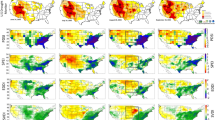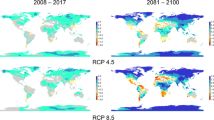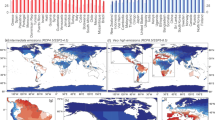Abstract
In addition to periodic long-term drought, much of Central America experiences a rainy season with two peaks separated by a dry period of weeks to over a month in duration, termed the mid-summer drought (MSD). Farmers in the region have adapted their activities to accommodate this phenomenon, anticipating its arrival and estimating its duration. Among the many impacts of global warming on the region are projected changes in precipitation amount, variability, and timing, with potential to affect agriculture and food security. Using gridded daily precipitation for a historic period with future projections, we characterize the MSD across much of Central America using four measures: onset date, duration, intensity, and minimum, and test for significant changes by the end of the twenty-first century. Our findings indicate that the most significant changes are for the duration, which is projected to increase by an average of over a week, and the MSD minimum precipitation, which is projected to decrease by an average of over 26%, with statistically significant changes for the mountains and Pacific side in most of Nicaragua, Honduras, El Salvador, and Guatemala (assuming a higher emissions pathway through the twenty-first century). These changes could portend important impacts on food security for vulnerable communities through the region. We find that for the four metrics, the changes in interannual variability are small compared to historical variability and are generally statistically insignificant.








Similar content being viewed by others
References
Alfaro EJ (2014) Caracterización del “veranillo” en dos cuencas de la vertiente del Pacífico de Costa Rica, América Central Revista de Biología Tropical. International Journal of Tropical Biology and Conservation 62:1–15. doi:10.15517/rbt.v62i4.20010
Amador JA, Alfaro EJ, Lizano OG, Magaña VO (2006) Atmospheric forcing of the eastern tropical Pacific. A review Progress in Oceanography 69:101–142. doi:10.1016/j.pocean.2006.03.007
Avelino J, Cristancho M, Georgiou S, Imbach P, Aguilar L, Bornemann G, Läderach P, Anzueto F, Hruska A, Morales C (2015) The coffee rust crises in Colombia and Central America (2008–2013): impacts, plausible causes and proposed solutions. Food Sec 7:303–321. doi:10.1007/s12571-015-0446-9
Bacon CM, Sundstrom WA, Flores Gómez ME, Ernesto Méndez V, Santos R, Goldoftas B, Dougherty I (2014) Explaining the ‘hungry farmer paradox’: smallholders and fair trade cooperatives navigate seasonality and change in Nicaragua's corn and coffee markets. Glob Environ Chang 25:133–149. doi:10.1016/j.gloenvcha.2014.02.005
Bacon CM, Sundstrom WA, Stewart IT, Beezer D (2017) Vulnerability to cumulative hazards: coping with the coffee leaf rust outbreak, drought, and food insecurity in Nicaragua, World Development 93:136–152 doi: https://doi.org/10.1016/j.worlddev.2016.12.025
Christensen JH, Hewitson B, Busuioc A, Chen A, Gao X, Held I, Jones R, Kolli RK, Kwon W-T, Laprise R, Magaña Rueda V, Mearns L, Menéndez CG, Räisänen J, Rinke A, Sarr A, Whetton P (2007) Regional climate projections. In: Solomon S et al (eds) Climate Change 2007: the physical science basis. Contribution of Working Group I to the Fourth Assessment Report of the Intergovernmental Panel on Climate Change. Cambridge University Press, Cambridge, United Kingdom and New York, NY, USA
Cleveland WS, Devlin SJ (1988) Locally weighted regression: an approach to regression analysis by local fitting. J Am Stat Assoc 83:596–610. doi:10.1080/01621459.1988.10478639
Curtis S (2002) Interannual variability of the bimodal distribution of summertime rainfall over Central America and tropical storm activity in the far-eastern Pacific. Clim Res 22:141–146
Dawson TP, Perryman AH, Osborne TM (2014) Modelling impacts of climate change on global food security. Clim Chang 134:429–440. doi:10.1007/s10584-014-1277-y
Demaria EMC, Maurer EP, Sheffield J, Bustos E, Poblete D, Vicuña S, Meza F (2012) Using a gridded global dataset to characterize regional hydroclimate in central Chile. J Hydrometeorol 14:251–265. doi:10.1175/jhm-d-12-047.1
Fowler HJ, Blenkinsop S, Tebaldi C (2007) Linking climate change modelling to impacts studies: recent advances in downscaling techniques for hydrological modelling. Int J Climatol 27:1547–1578. doi:10.1002/joc.1556
Fuss S, Canadell JG, Peters GP, Tavoni M, Andrew RM, Ciais P, Jackson RB, Jones CD, Kraxner F, Nakicenovic N, Le Quere C, Raupach MR, Sharifi A, Smith P, Yamagata Y (2014) Betting on negative emissions. Nature Clim Change 4:850–853. doi:10.1038/nclimate2392
Hannah L, Donatti CI, Harvey CA, Alfaro E, Rodriguez DA, Bouroncle C, Castellanos E, Diaz F, Fung E, Hidalgo HG, Imbach P, Läderach P, Landrum JP, Solano AL (2017) Regional modeling of climate change impacts on smallholder agriculture and ecosystems in. Central America Climatic Change 141:29–45. doi:10.1007/s10584-016-1867-y
Hawkins E, Sutton R (2011) The potential to narrow uncertainty in projections of regional precipitation change. Clim Dyn 37:407–418. doi:10.1007/s00382-010-0810-6
Herrera E, Magaña V, Caetano E (2015) Air–sea interactions and dynamical processes associated with the midsummer drought. Int J Climatol 35:1569–1578. doi:10.1002/joc.4077
Hidalgo HG, Alfaro EJ (2015) Skill of CMIP5 climate models in reproducing 20th century basic climate features in Central America. Int J Climatol 35:3397–3421. doi:10.1002/joc.4216
Hidalgo HG, Alfaro EJ, Quesada-Montano B (2017) Observed (1970–1999) climate variability in Central America using a high-resolution meteorological dataset with implication to climate change studies. Clim Chang 141:13–28. doi:10.1007/s10584-016-1786-y
Hidalgo HG, Amador JA, Alfaro EJ, Quesada B (2013) Hydrological climate change projections for Central America J Hydrol 495:94–112 doi:http://dx.doi.org/10.1016/j.jhydrol.2013.05.004
Hidalgo HG, Durán-Quesada AM, Amador JA, Alfaro EJ (2015) The Caribbean low level jet, the inter-tropical convergence zone and precipitation patterns in the Intra-Americas Sea: a proposed dynamical mechanism. Geografiska Annaler: Series A Phys Geogr 97:41–59. doi:10.1111/geoa.12085
Imbach P, Beardsley M, Bouroncle C, Medellin C, Läderach P, Hidalgo H, Alfaro E, Van Etten J, Allan R, Hemming D, Stone R, Hannah L, Donatti CI (2017) Climate change, ecosystems and smallholder agriculture in Central America: an introduction to the special issue. Clim Chang 141:1–12. doi:10.1007/s10584-017-1920-5
Karmalkar A, Bradley R, Diaz H (2011) Climate change in Central America and Mexico: regional climate model validation and climate change projections. Clim Dyn 37:605–629. doi:10.1007/s00382-011-1099-9
Karnauskas KB, Seager R, Giannini A, Busalacchi AJ (2013) A simple mechanism for the climatological midsummer drought along the. Pacific coast of Central America Atmósfera 26:261–281
Knutti R, Furrer R, Tebaldi C, Cermak J, Meehl GA (2010) Challenges in combining projections from multiple climate models. J Clim 23:2739–2758. doi:10.1175/2009jcli3361.1
Magaña V, Amador JA, Medina S (1999) The midsummer drought over Mexico and Central America. J Clim 12:1577–1588. doi:10.1175/1520-0442(1999)012>1577:tmdoma>2.0.co;2
Magrin GO, Marengo JA, Boulanger JP, Buckeridge MS, Castellanos E, Poveda G, Scarano FR, Vicuña S (2014) Central and South America. In: Barros VR et al (eds) Climate Change 2014: impacts, adaptation, and vulnerability. Part B: regional aspects. Contribution of Working Group II to the Fifth Assessment Report of the Intergovernmental Panel of Climate Change. Cambridge University Press, Cambridge, United Kingdom and New York, NY, USA, pp 1499–1566
Maldonado T, Rutgersson A, Alfaro E, Amador J, Claremar B (2016) Interannual variability of the midsummer drought in Central America and the connection with sea surface temperatures. Adv Geosci 42:35–50. doi:10.5194/adgeo-42-35-2016
Maloney ED, Camargo SJ, Chang E, Colle B, Fu R, Geilw KL, Hu Q, Jiang X, Johnson N, Karnauskas KB, Kinter J, Kirtman B, Kumar S, Langenbrunner B, Lombardo K, Long L, Mariotti A, Meyerson JE, Mo K, Neelin JD, Pan Z, Seager R, Serraw Y, Seth A, Sheffield J, Thibeault J, Xie S-P, Wang C, Wyman B, Zhao M (2014) North American climate in CMIP5 experiments: part III: assessment of 21st century projections. J Clim 27:2230–2270
Maurer EP, Adam JC, Wood AW (2009) Climate model based consensus on the hydrologic impacts of climate change to the Rio Lempa basin of. Central America Hydrol Earth System Sci 13:183–194
Maurer EP, Hidalgo HG, Das T, Dettinger MD, Cayan DR (2010) The utility of daily large-scale climate data in the assessment of climate change impacts on daily streamflow in. California Hydrol Earth System Sci 14:1125–1138. doi:10.5194/hess-1114-1125-2010
Mearns LO, Rosenzweig C, Goldberg R (1997) Mean and variance change in climate scenarios: methods, agricultural applications, and measures of uncertainty. Clim Chang 35:367–396. doi:10.1023/a:1005358130291
Meinshausen M, Smith S, Calvin K, Daniel J, Kainuma M, Lamarque JF, Matsumoto K, Montzka S, Raper S, Riahi K, Thomson A, Velders G, van Vuuren DP (2011) The RCP greenhouse gas concentrations and their extensions from 1765 to 2300. Clim Chang 109:213–241. doi:10.1007/s10584-011-0156-z
Méndez VE, Bacon CM, Cohen R (2013) Agroecology as a transdisciplinary, participatory, and action-oriented approach agroecology and sustainable food systems, 37:3–18 doi:10.1080/10440046.2012.736926
Osland M, González E, Richardson C (2011) Coastal freshwater wetland plant community response to seasonal drought and flooding in northwestern Costa Rica wetlands, 31:641–652 doi:10.1007/s13157-011-0180-9
Pierce DW, Barnett TP, Santer BD, Gleckler PJ (2009) Selecting global climate models for regional climate change studies. Proc National Academy Sci 106:8441–8446
Räisänen J (2002) CO2-induced changes in interannual temperature and precipitation variability in 19 CMIP2 experiments. J Clim 15:2395–2411. doi:10.1175/1520-0442(2002)015<2395:CICIIT>2.0.CO;2
Rauscher SA, Giorgi F, Diffenbaugh NS, Seth A (2008) Extension and intensification of the Meso-American mid-summer drought in the twenty-first century. Clim Dyn 31:551–571. doi:10.1007/s00382-00007-00359-00381
Rauscher SA, Kucharski F, Enfield DB (2011) The role of regional SST warming variations in the drying of Meso-America in future climate projections*. J Clim 24:2003–2016. doi:10.1175/2010jcli3536.1
Reardon T, Berdegué J, Escobar G (2001) Rural nonfarm employment and incomes in Latin America. Overview and Policy Implications World Development 29:395–409. doi:10.1016/S0305-750X (00)00112-1
Rind D, Goldberg R, Ruedy R (1989) Change in climate variability in the 21st century. Clim Chang 14:5–37. doi:10.1007/bf00140173
Sheffield J, Goteti G, Wood EF (2006) Development of a 50-yr high-resolution global dataset of meteorological forcings for land surface modeling. J Clim 19:3088–3111
Sheffield J, Langenbrunner B, Meyerson JE, Neelin JD, Camargo SJ, Fu R, Hu Q, Jiang X, Karnauskas KB, Kim ST, Kumar S, Kinter J, Maloney ED, Mariotti A, Pan Z, Ruiz-Barradas A, Nigam S, Seager R, Serra YL, Sun D-Z, Wang C, Yu J-Y, Johnson N, Xie S-P, Zhang T, Zhao M (2013) North American climate in CMIP5 experiments, Part II: evaluation of historical simulations of intra-seasonal to decadal variability. J Clim. doi:10.1175/jcli-d-12-00593.1
Sheffield J, Wood EF, Roderick ML (2012) Little change in global drought over the past 60 years. Nature 491:435–438. doi:10.1038/nature11575
Small RJO, de Szoeke SP, Xie S-P (2007) The Central American midsummer drought: regional aspects and large-scale forcing. J Clim 20:4853–4873. doi:10.1175/jcli104261.101171
Taylor KE, Stouffer RJ, Meehl GA (2012) An overview of CMIP5 and the experiment design. Bull Am Met Soc 93:485–498 doi: 410.1175/BAMS-D-1111-00094.00091
Taylor MA, Whyte FS, Stephenson TS, Campbell JD (2013) Why dry? Investigating the future evolution of the Caribbean low level jet to explain projected Caribbean drying. Int J Climatol 33:784–792. doi:10.1002/joc.3461
Tebaldi C, Arblaster JM (2014) Pattern scaling: its strengths and limitations, and an update on the latest model simulations. Clim Chang 122:459–471. doi:10.1007/s10584-013-1032-9
Thrasher B, Maurer EP, McKellar C, Duffy PB (2012) Technical note: bias correcting climate model simulated daily temperature extremes with quantile mapping. Hydrol Earth Syst Sci 16:3309–3314. doi:10.5194/hess-3316-3309-2012
van der Zee AA, van der Zee J, Meyrat A, Poveda C, Picado L (2012) Estudio de la caracterización del Corredor Seco Centroamericano. Organización de las Naciones Unidas para la Alimentación y la Agricultura. FAO, Tegulcigalpa, Honduras
van Vuuren D, Stehfest E, Elzen M, Kram T, Vliet J, Deetman S, Isaac M, Klein Goldewijk K, Hof A, Mendoza Beltran A, Oostenrijk R, Ruijven B (2011) RCP2.6: exploring the possibility to keep global mean temperature increase below 2 °C. Clim Chang 109:95–116. doi:10.1007/s10584-011-0152-3
Wilks DS (2006) Statistical methods in the atmospheric sciences, 2nd edn. Academic Press, New York, NY, USA
Wisner B, Gaillard JC, Kelman I (2012) Handbook of hazards and disaster risk reduction. Routledge, New York, NY
Wood AW, Leung LR, Sridhar V, Lettenmaier DP (2004) Hydrologic implications of dynamical and statistical approaches to downscaling climate model outputs. Clim Chang 62:189–216
Acknowledgements
Climate scenarios used were from the NEX-GDDP dataset, prepared by the Climate Analytics Group and NASA Ames Research Center using the NASA Earth Exchange, and distributed by the NASA Center for Climate Simulation (NCCS). This material is based upon work supported in part by the National Science Foundation under Grant No. 1539795.
Author information
Authors and Affiliations
Corresponding author
Additional information
Editor: Wolfgang Cramer
Rights and permissions
About this article
Cite this article
Maurer, E.P., Roby, N., Stewart-Frey, I.T. et al. Projected twenty-first-century changes in the Central American mid-summer drought using statistically downscaled climate projections. Reg Environ Change 17, 2421–2432 (2017). https://doi.org/10.1007/s10113-017-1177-6
Received:
Accepted:
Published:
Issue Date:
DOI: https://doi.org/10.1007/s10113-017-1177-6




